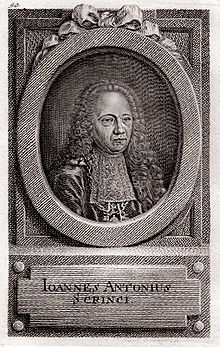Jan Antonín Scrinci
Johannes Antonius Josephus Scrinci also Johannes Antonius Josephus Scrinci or Jan Antonín Scrinci (born October 16, 1697 in Prague , † April 28, 1773 ibid) was a Bohemian doctor and scientist.
Life
Scrinci came from an Italian family of builders. Originally he wanted to study law, but after a fateful event he decided to pursue a medical career. When he happened to answer correctly for a poorly prepared student on a medical exam, he decided to steer his further career in this direction. In between he studied philosophy, traveled to Germany and Italy and devoted himself to natural science and physics. He completed his examination as one of the best students in 1728 and worked after his dissertation from 1734 to 1738 first in Schlan then in Jungbunzlau .
In the autumn of 1736 a disease spread in the Niemes area in northern Bohemia, the origin and symptoms of which puzzled doctors. Only after a precise analysis of the course of the disease and study of the causes - it was a question of poisoning by bread containing ergot alkaloids - Scrinci finally diagnosed the nervous disease ergotism . This research result opened the doors to Charles University in Prague for him in 1739 .
He taught as a full professor at the medical faculty and gave lectures on semiotics , since 1745 in chemistry and experimental physics. He gave his lectures according to the methods of Herman Boerhaave . The last-mentioned subjects in particular were extremely popular with the students because of their numerous experiments. He prepared his experiments in his apartment, where he set up a small laboratory. He was also known for developing his own instruments. He also took the students to pharmacies so that they could learn the practical preparation of medicines there. He also had the honor of demonstrating the experiment with Magdeburg hemispheres in 1754 in the Breunau Abbey to Empress Maria Theresa and her husband Franz I. Influenced by French scientists and the zeitgeist, surrounded by numerous enthusiastic scientists, he decided in 1753 to establish an Academy of Sciences in Prague. However, this proposal was rejected.
After the siege of Prague by the Prussians in 1758, he finished his lectures, fell ill and was primarily concerned with saving his collections. He spent more and more time in the church and ministered to the priests there as often as the illness allowed him.
From 1756 to 1757 and 1760 to 1761 he was appointed rector of the university because of his outstanding scientific work.
Works
His main works dealt with medicine. Med. Siles. Satyr. IV., De febri castrensi Gallorum in Bohemia 1742, De ossium natura horumque inflammatione in genere 1743, De doloribus in genere 1746, De puncto aut scisso nervo atque tendine 1748, De organo, sensu et objecto olfactus 1749, De organo, sensu et objecto tactus 1749, De utilitate electrisationis in arte medica seu in curandis morbis 1751, De principio aut causa corpus animale formante 1756, De balneo Theodori prope Pragam 1741, Tractatus de fontibus soteriis Toeplitzensibus in regno Bohemiae 1756, De phialis Bononienscioli 1747, De oleo vitrioli dulrioli 1747 1753, De arcano tartari 1753, De aëris proprietatibus 1743.
literature
- Constantin von Wurzbach : Scrinci, Johann Anton . In: Biographisches Lexikon des Kaiserthums Oesterreich . 33. Part. Kaiserlich-Königliche Hof- und Staatsdruckerei, Vienna 1877, pp. 219–221 ( digitized version ).
- Ottův slovník naučný
| personal data | |
|---|---|
| SURNAME | Scrinci, Jan Antonín |
| ALTERNATIVE NAMES | Scrinci, Johannes Antonius Josephus |
| BRIEF DESCRIPTION | bohemian doctor and scientist |
| DATE OF BIRTH | October 16, 1697 |
| PLACE OF BIRTH | Prague |
| DATE OF DEATH | April 28, 1773 |
| Place of death | Prague |
